Verdict
The Campfire Orbit is a pricey but entertaining first true wireless that possesses a warm, rich audio performance. These wireless earbuds are geared towards the audio purists, lacking comfort features such as active noise-cancellation and transparency modes.
Pros
- Rich and bold presentation
- Good comfort levels
- Solid passive noise isolating design
- Above average call quality
Cons
- Sound is short of outright clarity and definition
- Pricey for true wireless without ANC or transparency mode
- App EQ options aren’t explained
Availability
- UKRRP: £249
- USARRP: $249
- EuropeTBC
- CanadaTBC
- AustraliaTBC
-
10mm Liquid Crystal Polymer (LCP) dynamic driveUsed for a clearer, spacious and energetic performance -
Equaliser7-band custom EQ and preset selection
Introduction
Campfire Audio has established itself as a provider of high-end in-ear monitors (IEMs) but so far, they’ve operated in the wired market. That’s all changed with the Campfire Orbit.
The Orbit is the brand’s first true wireless, and while it’s a small step for a wireless earbud, it’s a big leap for Campfire Audio. It’s now in a market and at a price where Sony, Bose and Bowers & Wilkins are on similar trajectories.
The Campfire Orbit are like Astell & Kern’s first foray in the true wireless market, eschewing active noise-cancellation and diving headfirst into high quality wireless sound. With that in mind, just how high does the Orbit reach?
Design
- Compact profile
- Good looks
- Solid noise isolation
- IPX5 water resistance
Compact and lightweight are watchwords for the Campfire Orbit. They’re not as chunky as their Andromeda counterparts, but they take on the same appearance.
The matte finish is a pleasant dual tone: light and dark orange colours, which is the only finish the Orbit comes in. The hexagonal, chunky design ensures they fit tightly in the ear, although I’m always aware of them once they’re in.
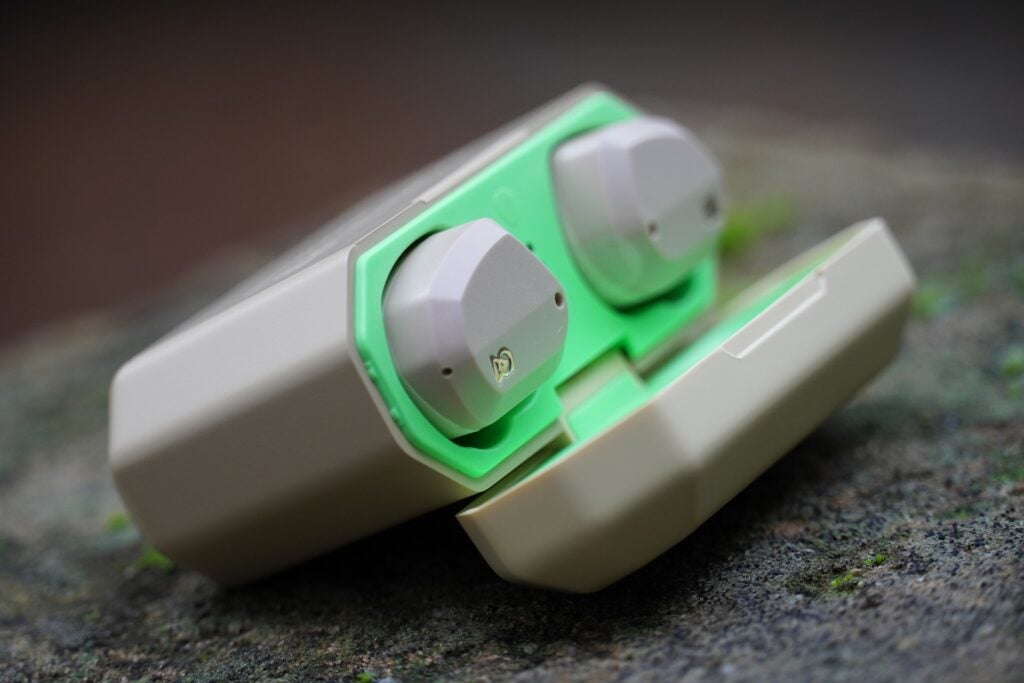
The Orbit can feel a little loose, so while there’s some wiggle room to find a better fit, there’s also some movement walking around (the larger ear-tip reduces that feeling, but not altogether). A few ear-tips are provided from marshmallow tips (small to large) and silicone ear-tips (also small to large) to find the desired fit and comfort levels.
And despite their chunkiness, I’ve had no issues in terms of comfort. When in position, the passive noise isolating qualities of the buds work well enough. Some noises pass through their defences, but voices are reduced in general – the screaming of a baby was more tolerable on a train – and music wasn’t overwhelmed on the tube. They’re effective at blotting out noise to the point where I don’t overly miss noise-cancellation.
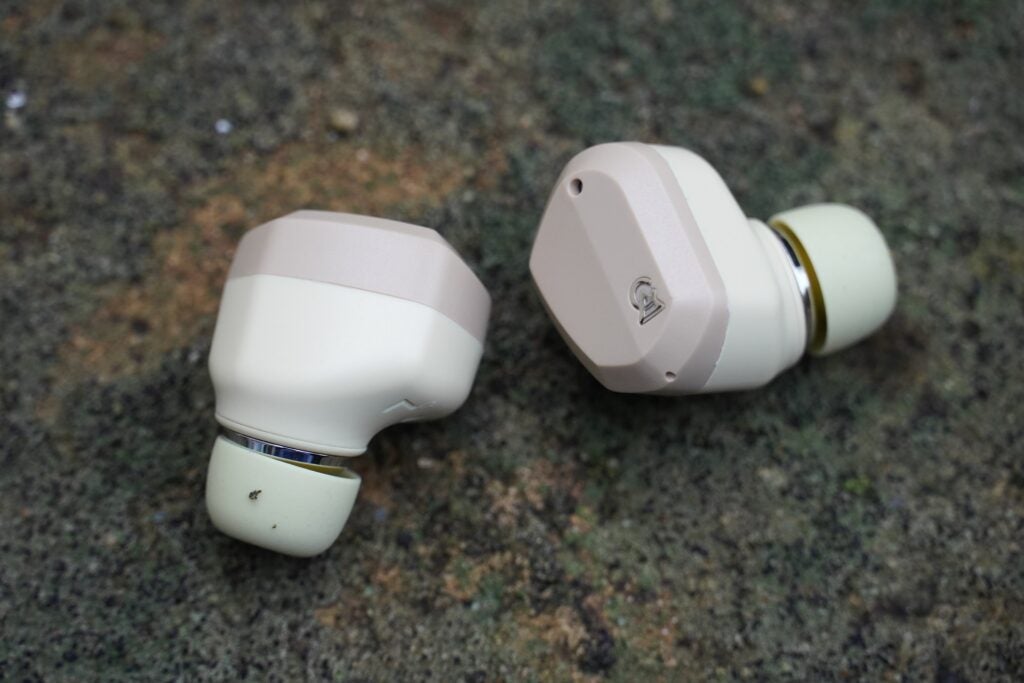
I did find the controls could be too sensitive. The problem seemed related to how they were seated, as brushing against my earlobe seemed to trigger the controls. The concern seemed to have weeded itself out and having tried this bud on Android and iOS devices, no further troubles were had.
Controls cover playback (tap) track skipping (double tap), volume (long press) and engaging with a mobile device’s voice assistant (triple tap). You can also manage calls and in the Campfire app customisation of controls amounts to toggling them on or off. It’s not the same as assigning controls, but handy if you find there are controls you don’t use and therefore don’t need.
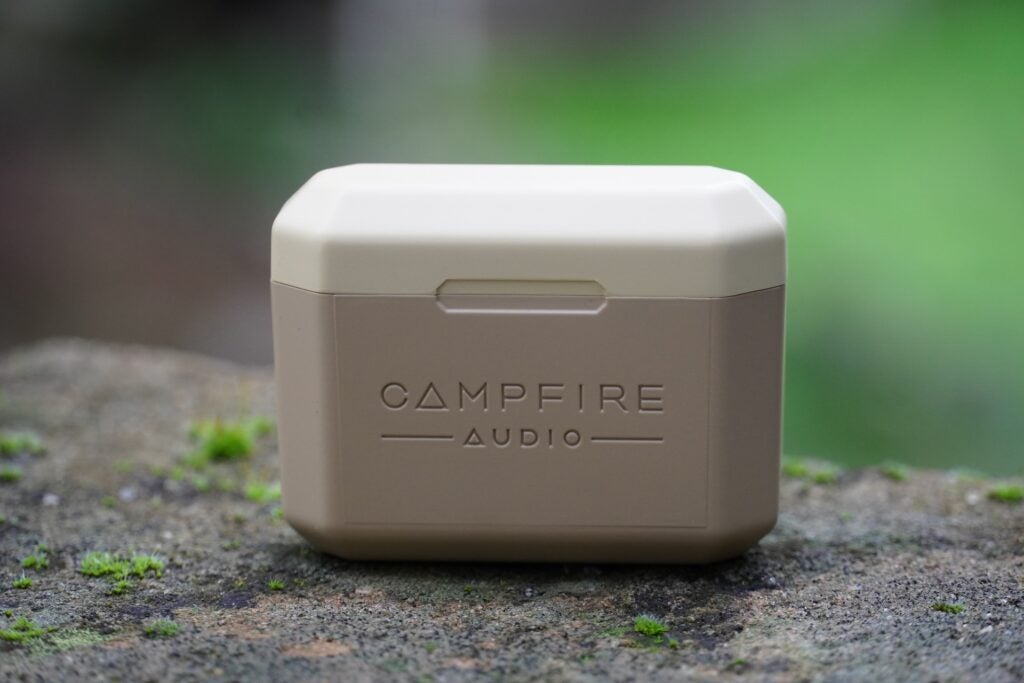
The case is very petite – small enough that extracting the buds takes a few tries – and slips easily into a pocket, sharing the same angular design language and colour scheme. Inside is a mint green colour scheme, and while the contrast is strange, I like it. Also inside (rather than out) is a row of four LED lights that signal how much charge is left. Below is the Bluetooth pairing button for connecting to a new device.
The buds are rated to the IPX5 standard; strong enough to resist a sustained, low-pressure water spray. Some wet weather and perhaps even a gentle rinse should be ok, along with outdoor exercise and gym use.
Features
- AptX Bluetooth compatible
- Above average call quality
- Battery life a little less than expected
The highest level of Bluetooth support the Campfire Orbit has is aptX, and while it’s not the highest performing Qualcomm codec, it is enough for 16-bit depth and sampling rate of 48kHz – though aptX’s bitrate is short of CD quality. With SBC and AAC, you’re covered if you don’t have an aptX-compatible mobile device.
The stability of the Bluetooth connection was steady at Waterloo and Victoria stations, though fluctuated walking through The Cut in Waterloo and signal distortion was evident. The Campfire Orbit’s connection is solid enough but trips up in some unexpected places.

Call quality performance is above average. The person on the other end heard me clearly and most background noises weren’t an issue. What did cause problems was wind noise, which caused my voice to sound distant, and loud passing noises seemed too much for the earphones to block out.
Campfire rates the battery at around 30 hours in total, with 8.5 hours per charge (at 80% volume). Draining the battery with a Spotify playlist for an hour saw battery levels drop to around 84%. If the Campfire Orbit continues to drain at that rate they’re good for just over six hours of listening. You can get them back up to speed by charging via cable (USB-C) or wireless (Qi charging).
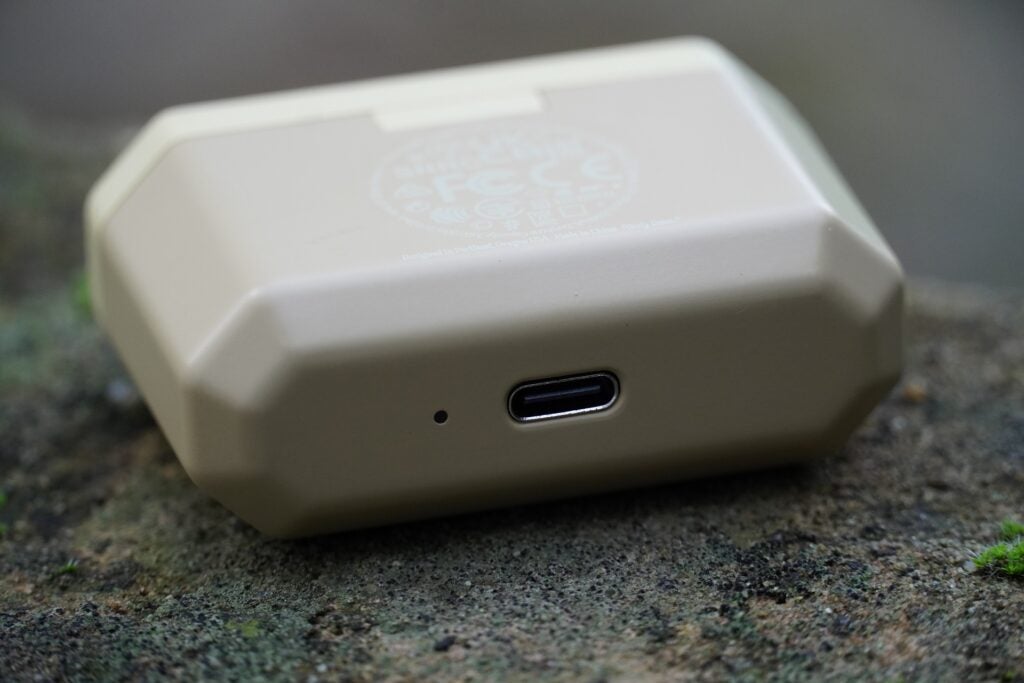
The companion app has a basic interface that’s mostly comprehensible. There’s a selection of seven EQ presets, though they’re all numbered with no description attached (the manual is of zero help). All you can do is tap through to hear the differences. You can also create one with a 7-band EQ that ranges from 32 to 14k.
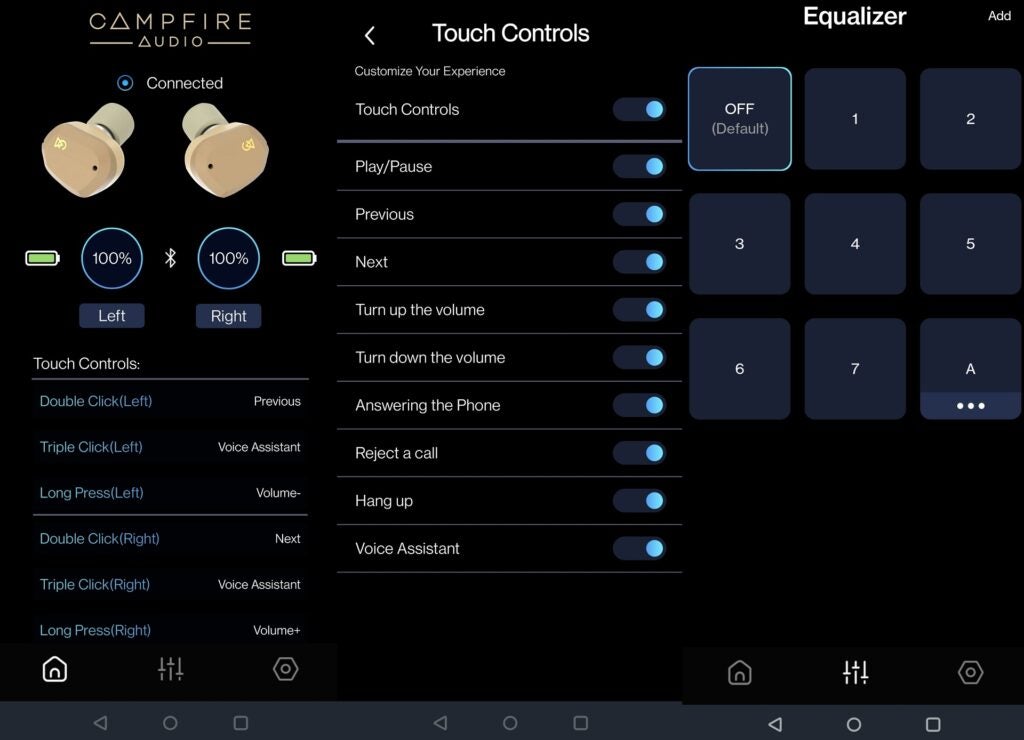
Sound Quality
- Rich, warm presentation
- Big and firm vocal presence
- Assertive bass
The Orbit‘s presentation is a bold, rich and thoroughly enjoyable one, but comes with caveats, namely that they’re short on a more precise sense of definition and detail.
The Orbit plays music in broad strokes, its warmth while enjoyable also serves to highlight a lack of outright clarity and fidelity the Sony WF-1000XM4 can offer, for example. With Michael Giacchino’s Commitment, the warmth of the Orbit offers a large, textured, energetic presentation; but the WF-1000XM4 offer clearer separation of the orchestra sections, which in turn relays a better sense of definition and detail.

But if you like music with plenty of gusto, verve, and drama then the Campfire Orbit is a tonic to the ears. And it’s interesting how the Orbit conveys its soundstage. Where some true wireless pitch instruments and vocals in front of the listener, the Orbit’s soundstage is spread out big and tall, and closer to the listener in a way that puts them right in the middle of things.
The midrange is, unsurprisingly, fettered with warmth. Voices are big in size, and firmly defined whether male or female. I would say they lack a degree of subtlety, but it’s in keeping with the Orbit’s overall view. They’re a bold and unambiguously big-sounding true wireless.
Towards the higher end of the frequency the Orbit is richer than necessarily bright and sharp, bringing out the horn notes of a trumpet in the jazz version of This is America (feat. Keyon Harrold). There’s an element of the treble sounding rolled off in GoGo Penguin’s Erased by Sunlight, but there’s enough information and variation presented to prevent high frequencies sounding too muted, though I prefer the Sony’s more balanced approach.
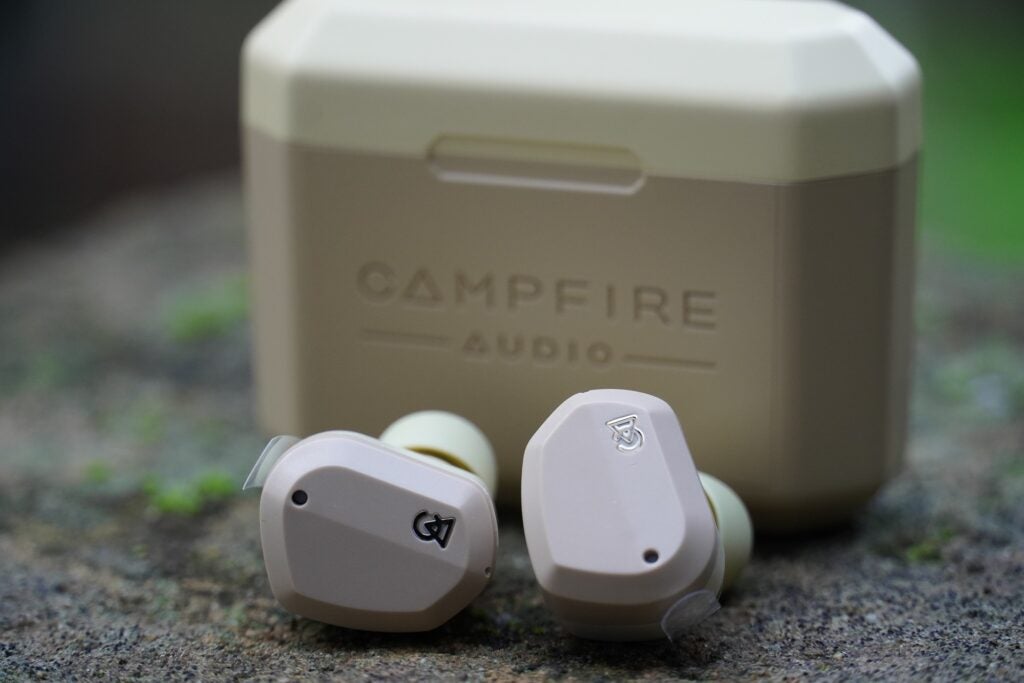
The bass is powerful and assertive, and it can arguably dominate proceedings. I have noticed bass can sound a little hard in places – bass is punchy rather than deep and rumbly. A play around with the EQ settings can offer some subtle changes or simply turn the processing off altogether.
Most of this review was conducted with the EQ 7 and ‘Off’ options; the former sounds slightly bigger than the rest (option 6 seems to focus on voices). As far as I can tell, the difference between all the EQ options isn’t massive, so whichever profile is chosen you’re getting a similar sound.
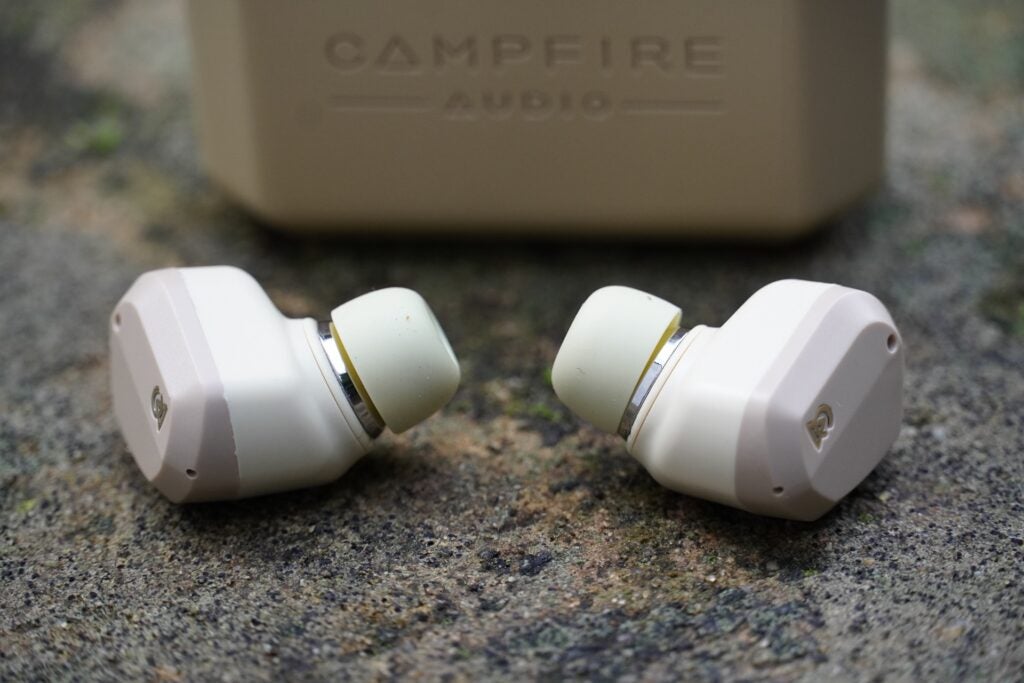
Latest deals
Should you buy it?
If you like audio that’s like a warm bath:
Rich, bold and expansive are a few words to describe the Orbit’s audio profile. If that’s what you like, that’s what you get.
You want more detail and clarity:
These are earphones that appeal to those after a high-quality experience, but their warm approach does leave them short versus others in terms of overall detail, definition, and clarity.
Final Thoughts
The Campfire Orbit is a rich, warm sonic bath and there are both benefits and handicaps to that approach. But if you like music presented in a big, bold, and energetic manner, the Orbit are not shy about coming forward.
They do lack outright clarity and definition compared to similarly priced true wireless, and they lack convenient features such as active noise-cancellation and transparency modes. In that context, a purchase of these earbuds will be down to how you feel about its sonic approach.
How we test
We test every set of headphones we review thoroughly over an extended period of time. We use industry standard tests to compare features properly. We’ll always tell you what we find. We never, ever, accept money to review a product.
Find out more about how we test in our ethics policy.
Tested with real world use
Compared against other true wireless
FAQs
The Orbit supports neither noise-cancellation or any transparency mode, so if you’re looking for those features you’d need to look elsewhere.
Sustainability
Trusted Reviews’ holds the fact that global warming is not a myth as a core value and will continuously endeavour to help protect our planet from harm in its business practices.
As part of this mission, whenever we review a product we send the company a series of questions to help us gauge and make transparent the impact the device has on the environment.
We currently haven’t received answers to the questions on this product, but will update this page the moment we do. You can see a detailed breakdown of the questions we ask and why in our sustainability info page
Jargon buster
IP rating
An abbreviation for ‘Ingress Protection Code’, which lets you know to what extent a device might be waterproof or dustproof.
Bluetooth
Bluetooth – named after 10th-century Danish king Harald Bluetooth who united Denmark’s tribes into a single kingdom – is a method of wireless transmission that allows for the exchange of data between devices over short distances.
Verdict
The Campfire Orbit is a pricey but entertaining first true wireless that possesses a warm, rich audio performance. These wireless earbuds are geared towards the audio purists, lacking comfort features such as active noise-cancellation and transparency modes.
Pros
- Rich and bold presentation
- Good comfort levels
- Solid passive noise isolating design
- Above average call quality
Cons
- Sound is short of outright clarity and definition
- Pricey for true wireless without ANC or transparency mode
- App EQ options aren’t explained
Availability
- UKRRP: £249
- USARRP: $249
- EuropeTBC
- CanadaTBC
- AustraliaTBC
-
10mm Liquid Crystal Polymer (LCP) dynamic driveUsed for a clearer, spacious and energetic performance -
Equaliser7-band custom EQ and preset selection
Introduction
Campfire Audio has established itself as a provider of high-end in-ear monitors (IEMs) but so far, they’ve operated in the wired market. That’s all changed with the Campfire Orbit.
The Orbit is the brand’s first true wireless, and while it’s a small step for a wireless earbud, it’s a big leap for Campfire Audio. It’s now in a market and at a price where Sony, Bose and Bowers & Wilkins are on similar trajectories.
The Campfire Orbit are like Astell & Kern’s first foray in the true wireless market, eschewing active noise-cancellation and diving headfirst into high quality wireless sound. With that in mind, just how high does the Orbit reach?
Design
- Compact profile
- Good looks
- Solid noise isolation
- IPX5 water resistance
Compact and lightweight are watchwords for the Campfire Orbit. They’re not as chunky as their Andromeda counterparts, but they take on the same appearance.
The matte finish is a pleasant dual tone: light and dark orange colours, which is the only finish the Orbit comes in. The hexagonal, chunky design ensures they fit tightly in the ear, although I’m always aware of them once they’re in.

The Orbit can feel a little loose, so while there’s some wiggle room to find a better fit, there’s also some movement walking around (the larger ear-tip reduces that feeling, but not altogether). A few ear-tips are provided from marshmallow tips (small to large) and silicone ear-tips (also small to large) to find the desired fit and comfort levels.
And despite their chunkiness, I’ve had no issues in terms of comfort. When in position, the passive noise isolating qualities of the buds work well enough. Some noises pass through their defences, but voices are reduced in general – the screaming of a baby was more tolerable on a train – and music wasn’t overwhelmed on the tube. They’re effective at blotting out noise to the point where I don’t overly miss noise-cancellation.

I did find the controls could be too sensitive. The problem seemed related to how they were seated, as brushing against my earlobe seemed to trigger the controls. The concern seemed to have weeded itself out and having tried this bud on Android and iOS devices, no further troubles were had.
Controls cover playback (tap) track skipping (double tap), volume (long press) and engaging with a mobile device’s voice assistant (triple tap). You can also manage calls and in the Campfire app customisation of controls amounts to toggling them on or off. It’s not the same as assigning controls, but handy if you find there are controls you don’t use and therefore don’t need.

The case is very petite – small enough that extracting the buds takes a few tries – and slips easily into a pocket, sharing the same angular design language and colour scheme. Inside is a mint green colour scheme, and while the contrast is strange, I like it. Also inside (rather than out) is a row of four LED lights that signal how much charge is left. Below is the Bluetooth pairing button for connecting to a new device.
The buds are rated to the IPX5 standard; strong enough to resist a sustained, low-pressure water spray. Some wet weather and perhaps even a gentle rinse should be ok, along with outdoor exercise and gym use.
Features
- AptX Bluetooth compatible
- Above average call quality
- Battery life a little less than expected
The highest level of Bluetooth support the Campfire Orbit has is aptX, and while it’s not the highest performing Qualcomm codec, it is enough for 16-bit depth and sampling rate of 48kHz – though aptX’s bitrate is short of CD quality. With SBC and AAC, you’re covered if you don’t have an aptX-compatible mobile device.
The stability of the Bluetooth connection was steady at Waterloo and Victoria stations, though fluctuated walking through The Cut in Waterloo and signal distortion was evident. The Campfire Orbit’s connection is solid enough but trips up in some unexpected places.

Call quality performance is above average. The person on the other end heard me clearly and most background noises weren’t an issue. What did cause problems was wind noise, which caused my voice to sound distant, and loud passing noises seemed too much for the earphones to block out.
Campfire rates the battery at around 30 hours in total, with 8.5 hours per charge (at 80% volume). Draining the battery with a Spotify playlist for an hour saw battery levels drop to around 84%. If the Campfire Orbit continues to drain at that rate they’re good for just over six hours of listening. You can get them back up to speed by charging via cable (USB-C) or wireless (Qi charging).

The companion app has a basic interface that’s mostly comprehensible. There’s a selection of seven EQ presets, though they’re all numbered with no description attached (the manual is of zero help). All you can do is tap through to hear the differences. You can also create one with a 7-band EQ that ranges from 32 to 14k.

Sound Quality
- Rich, warm presentation
- Big and firm vocal presence
- Assertive bass
The Orbit‘s presentation is a bold, rich and thoroughly enjoyable one, but comes with caveats, namely that they’re short on a more precise sense of definition and detail.
The Orbit plays music in broad strokes, its warmth while enjoyable also serves to highlight a lack of outright clarity and fidelity the Sony WF-1000XM4 can offer, for example. With Michael Giacchino’s Commitment, the warmth of the Orbit offers a large, textured, energetic presentation; but the WF-1000XM4 offer clearer separation of the orchestra sections, which in turn relays a better sense of definition and detail.

But if you like music with plenty of gusto, verve, and drama then the Campfire Orbit is a tonic to the ears. And it’s interesting how the Orbit conveys its soundstage. Where some true wireless pitch instruments and vocals in front of the listener, the Orbit’s soundstage is spread out big and tall, and closer to the listener in a way that puts them right in the middle of things.
The midrange is, unsurprisingly, fettered with warmth. Voices are big in size, and firmly defined whether male or female. I would say they lack a degree of subtlety, but it’s in keeping with the Orbit’s overall view. They’re a bold and unambiguously big-sounding true wireless.
Towards the higher end of the frequency the Orbit is richer than necessarily bright and sharp, bringing out the horn notes of a trumpet in the jazz version of This is America (feat. Keyon Harrold). There’s an element of the treble sounding rolled off in GoGo Penguin’s Erased by Sunlight, but there’s enough information and variation presented to prevent high frequencies sounding too muted, though I prefer the Sony’s more balanced approach.

The bass is powerful and assertive, and it can arguably dominate proceedings. I have noticed bass can sound a little hard in places – bass is punchy rather than deep and rumbly. A play around with the EQ settings can offer some subtle changes or simply turn the processing off altogether.
Most of this review was conducted with the EQ 7 and ‘Off’ options; the former sounds slightly bigger than the rest (option 6 seems to focus on voices). As far as I can tell, the difference between all the EQ options isn’t massive, so whichever profile is chosen you’re getting a similar sound.

Latest deals
Should you buy it?
If you like audio that’s like a warm bath:
Rich, bold and expansive are a few words to describe the Orbit’s audio profile. If that’s what you like, that’s what you get.
You want more detail and clarity:
These are earphones that appeal to those after a high-quality experience, but their warm approach does leave them short versus others in terms of overall detail, definition, and clarity.
Final Thoughts
The Campfire Orbit is a rich, warm sonic bath and there are both benefits and handicaps to that approach. But if you like music presented in a big, bold, and energetic manner, the Orbit are not shy about coming forward.
They do lack outright clarity and definition compared to similarly priced true wireless, and they lack convenient features such as active noise-cancellation and transparency modes. In that context, a purchase of these earbuds will be down to how you feel about its sonic approach.
How we test
We test every set of headphones we review thoroughly over an extended period of time. We use industry standard tests to compare features properly. We’ll always tell you what we find. We never, ever, accept money to review a product.
Find out more about how we test in our ethics policy.
Tested with real world use
Compared against other true wireless
FAQs
The Orbit supports neither noise-cancellation or any transparency mode, so if you’re looking for those features you’d need to look elsewhere.
Sustainability
Trusted Reviews’ holds the fact that global warming is not a myth as a core value and will continuously endeavour to help protect our planet from harm in its business practices.
As part of this mission, whenever we review a product we send the company a series of questions to help us gauge and make transparent the impact the device has on the environment.
We currently haven’t received answers to the questions on this product, but will update this page the moment we do. You can see a detailed breakdown of the questions we ask and why in our sustainability info page
Jargon buster
IP rating
An abbreviation for ‘Ingress Protection Code’, which lets you know to what extent a device might be waterproof or dustproof.
Bluetooth
Bluetooth – named after 10th-century Danish king Harald Bluetooth who united Denmark’s tribes into a single kingdom – is a method of wireless transmission that allows for the exchange of data between devices over short distances.

























